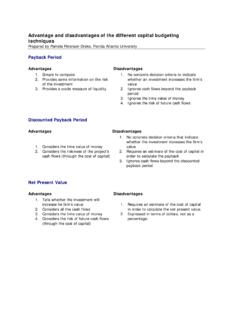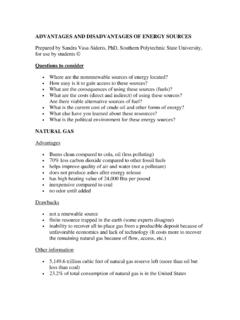Transcription of Advantages and Disadvantages of Different Types …
1 1 Presented by John S. Levine, Lectronics and Lectric, Glover Resistors, and Disadvantages of Different Types of Neutral Grounding Systems2 OBJECTIVES1. Discuss five Types of grounding for power Discuss Advantages of high resistance Show equipmentNEUTRAL GROUNDING OF POWER SYSTEMS3 POWER SYSTEM GROUNDINGP ower system grounding is a connection between an electrical circuit or equipment and the earth or to some conducting body that serves in place of presentation concerns the design of power system grounding for industrial and commercial facilities not utility OF GROUNDING1. The ungrounded system2. The solidly grounded system3. Reactive grounding4. Low resistance grounding of power systems5. High resistance grounding of power systems5 Are You at Risk?Are You at Risk?Are You at Risk?Do you use electricity?Electrical deficiencies are the leading ignition source and cause of fire and is a Ground Fault?
2 Contact between ground and an energized conductorUnleashes large amount of electrical energyDangerous toequipment and people7 POWER SYSTEM GROUNDINGSYSTEM FAILURES SHORT CIRCUITS(FAULTS)INDUSTRIAL POWER SYSTEMS1. LINE TO GROUND2. PHASE - PHASE3. THREE PHASEFAILURE MODEPERCENTAGEOF FAILURESMost three phase faults are man- Accidents caused by improper operating %< %<.5 %8 Two Types of FaultsTwo Types of FaultsBolted FaultsSolid connection between two phases or phase and ground resulting in high fault are well contained so fault creates less FaultsUsually caused by insulation breakdown, creating an arc between two phases or phase to energy is not well contained, and can be very FaultsBolted FaultsResult from a solid connection accidentally being made between two phases of the system or between one phase and an adjacent grounded metal surface. Because they are low resistance, high current events, this type of fault may actually be less destructive because the energy is spread over a large area and the protective devices are activated very rapidly by the large Types of electrical equipment with a withstand and/or interrupting rating are tested using bolted fault majority of the stresses (thermal and mechanical) are confined within the bus-bar and associated supports, so very little arc flash / blast occurs, if any at all.
3 10600 Volt THHN Power Cable on Ungrounded SystemArcing FaultArcing Fault11 Arc FaultUsually caused by insulation breakdown, an arc jumps between two phases or between one phase and a grounded metal resulting fault current is smaller because of the relatively high resistance of the arc (25-40% of a bolted fault). Protective devices may be slow in responding to the smaller fault faults can be the most destructive because of the intense energy that is concentrated in the small area of the majority of the stresses (thermal and mechanical) are notconfined within the bus-bar and associated supports, it extends to the space in the ARCING FAULTAn arcing fault is an intermittent failure between phases or phase to ground. It is a discontinuous current that alternately strikes, is extinguished and restrikes again. For solidly grounded systems, the arc currents are: in percent of bolted three phase faultedFAULTSTHREE PHASE89%LINE-LINE74%LINE-GROUND38%13 Arcing Ground FaultsArcing Ground FaultsIntermittent or ReIntermittent or Re--strikestrikeIntermittent ground fault:A re-striking ground fault can create a high frequency oscillator (RLC circuit), independent of L and C values, causing high transient over-voltages.
4 Re-striking due to ac voltage waveform or loose wire caused by vibrationVV480V Delta Source3 LoadCbbCRfefaS1415 Plot of transient over-voltage for an arcing ground faultArcing Ground FaultsArcing Ground FaultsIntermittent or ReIntermittent or Re--strikestrike16 Industry RecommendationsIEEE Std 242-2001 (Buff Book)Recommended Practice for Protection and Coordination of Industrial and Commercial Power If this ground fault is intermittent or allowed to continue, the system could be subjected to possiblesevere over-voltages to ground, which can be as high as six to eight timesphase over-voltages can puncture insulation and result in additional ground faults. These over-voltages are caused by repetitive charging of the system capacitance or by resonance between the system capacitance and the inductance of equipment in the UNGROUNDED POWER SYSTEM18 THE UNGROUNDEDED POWER SYSTEM19 UNGROUNDED SYSTEM NORMAL CONDITIONS20 UNGROUNDED SYSTEM NORMAL CONDITIONS21 UNGROUNDED SYSTEMGROUND FAULT ON PHASE A22 UNGROUNDED SYSTEM GROUND FAULT ON PHASE A23 THE UNGROUNDED POWER SYSTEMGROUND DETECTION CIRCUIT24 THE UNGROUNDED POWER SYSTEMGROUND DETECTION CIRCUIT25 THE UNGROUNDED POWER SYSTEMGROUND DETECTION CIRCUIT WITH ALARM26 THE UNGROUNDED POWER SYSTEMADVANTAGES1.
5 Low value of current flow for line to ground fault-5amps or No flash hazard to personnel for accidental line to ground Continued operation on the occurrence of first line to ground Probability of line to ground arcing fault escalating to line line or three phase fault is very UNGROUNDED POWER SYSTEMDISADVANTAGES1. Difficult to locate line to ground The ungrounded system does not control transient Cost of system maintenance is higher due to labor of locating ground A second ground fault on another phase will result in a phase-phase short circuit. 28 THE SOLIDLY GROUNDED POWER SYSTEM29 THE SOLIDLY GROUNDED POWER SYSTEM30 SOLIDLY GROUNDED SYSTEMTHREE PHASE SHORT CIRCUIT31 SOLIDLY GROUNDED SYSTEMTHREE PHASE SHORT CIRCUIT32 SOLIDLY GROUNDED SYSTEM LINE GROUND SHORT CIRCUIT33 SOLIDLY GROUNDED SYSTEMLINE GROUND SHORT CIRCUIT34 SOLIDLY GROUNDED SYSTEMLINE-LINE SHORT CIRCUIT35 THE SOLIDLY GROUNDED POWER SYSTEMLINE TO GROUND FAULT36 Industry RecommendationsIEEE Std 141-1993 (Red Book)Recommended Practice for Electric Power Distribution for Industrial The solidly grounded system has the highest probability of escalating into a phase-to-phase or three-phase arcing fault, particularly for the 480V and 600V systems.
6 The danger of sustained arcing for phase-to-ground fault probability is also high for the 480V and 600V systems, and low for the 208V systems. For this reason ground fault protection is shall be required for system 1000A or more (NEC ). A safety hazard exists for solidly grounded systems from the severe flash, arc burning, and blast hazard from any phase-to-ground SOLIDLY GROUNDED POWER SYSTEMADVANTAGES1. Controls transient over voltage from neutral to Not difficult to locate the Can be used to supply line-neutral loads38 THE SOLIDLY GROUNDED POWER SYSTEMDISADVANTAGES1. Severe flash hazard2. Main breaker required3. Loss of production4. Equipment damage5. High values of fault current6. Single-phase fault escalation into 3 phase fault is likely7. Creates problems on the primary system39 NEUTRAL GROUNDING RESISTOR 40 Reactive GroundingReactive GroundingUses reactor not resistorFault values of transient-overvoltages are unacceptable in industrial environmentsTypically found in high voltage applications (>46 kV)41 LOW RESISTANCE GROUNDING OF POWER SYSTEMS42 LOW RESISTANCE GROUNDING OF POWER SYSTEMSThis design is generally for the following systems: At kv through 14,400 kv.
7 Systems serving motor loads Current is limited to 200 to 400 amps Systems typically designed to shut down in 10 seconds43 LOW RESISTANCE GROUNDED POWER SYSTEMS44 LOW RESISTANCE GROUNDEDZERO SEQUENCE RELAYING PARTIAL SINGLE LINE45 LOW RESISTANCE GROUNDED POWER SYSTEMS400 AMP GROUNDINGD isadvantages Relatively large ground fault is required and thermal damge and core restacking is possible The faulted machine is shutdown Starter fuse may also operate Must trip upstream circuit breaker. Has been replaced by high resistance grounded systems with modern ct s and 400 amp grounding does look at a large part of the machine RESISTANCE GROUNDING OF POWER SYSTEMS47 THE HIGH RESISTANCE GROUNDED POWER SYSTEM48No Single Phase LoadsNo Single Phase LoadsNo line-to-neutral loads allowed, prevents B C 3 LoadHRG480V Wye SourceN0V277 VGround A Line-to-neutral Voltage is backfed via neutral wire, thus, not RESISTANCE GROUNDING AN EXAMPLE50 HIGH RESISTANCE GROUNDING GROUND FAULT ON PHASE A51 HIGH RESISTANCE GROUNDING GROUND FAULT ON PHASE A52 HIGH RESISTANCE GROUNDED SYSTEMLINE-GROUND SHORT CIRCUIT53 THE HIGH RESISTANCE GROUNDED POWER SYSTEMCONTROL OF TRANSIENT OVERVOLTAGE54 HIGH RESISTANCE GROUNDING55 THE HIGH RESISTANCE GROUNDED POWER SYSTEMLINE GROUND FAULTS DELTA CONNECTED MOTORS56 THE HIGH RESISTANCE GROUNDED POWER SYSTEMLINE-GROUND FAULTS WYE CONNECTED MOTORS57 HIGH RESISTANCE GROUNDING OF A 2400 VOLT SYSTEM58 THE HIGH RESISTANCE GROUNDED POWER SYSTEMCHOOSING THE GROUND RESISTORA lways specify a continuously rated resistor for 5 amps for all system VOLTAGERESISTORAMPSRESISTOR OHMSRESISTORWATTS(CONTINUOUS) , , , ,925330052957,3754160548012,00059 THE HI-R GROUNDED POWER SYSTEMADVANTAGES1.
8 Low value of fault current2. No flash hazard3. Controls transient over voltage4. No equipment damage5. Service continuity6. No impact on primary system60 HOW DO YOU FIND GROUND FAULTS?UngroundedSolidly groundedLow resistance groundedHigh resistance grounded61 HIGH RESISTANCE GROUNDING GROUND FAULT ON PHASE A62 PROCEDURE FOR LOCATING GROUND FAULT1. Alarm indicates ground Technician confirms ground faults by visiting Voltage on meter relay4. Current through ground Substation zero sequence feeder ammeters will indicate specific feeder to MCC or Power Distribution to specific MCC or PDP, open wireway and use clamp-on ammeter around outgoing leads to determine failed Evaluate need to replace or fix Fault Location MethodGround Fault Location MethodNOTE:Tracking a ground fault can only be done on an energized system. Due to the inherent risk of electrocution this should only be performed by trained and competent personnel.
9 64 Fault LocationFault LocationMethod to quickly locate ground Wye Source85AC B A reading will alternate from 5A to 10A every 2 IEEEPer HRG OR NOT TO HRG?IEEE Std 142-1991 (Green Book)Recommended Practice for Grounding of Industrial and Commercial Power reasons for limiting the current by resistance grounding may be one or more of the )To reduce burning and melting effectsin faulted electric equipment, such as switchgear, transformers, cables, and rotating )To reduce mechanical stressesin circuits and apparatus carrying fault )To reduce electric-shock hazards to personnelcaused by stray ground-fault currents in the ground return IEEEPer HRG OR NOT TO HRG?IEEE Std 142-1991 (Green Book)Recommended Practice for Grounding of Industrial and Commercial Power reasons for limiting the current by resistance grounding may be one or more of the )To reduce the arc blast or flash hazard to personnelwho may have accidentally caused or who happen to be in close proximity to the ground ) To reduce the momentary line-voltage dipoccasioned by the clearing of a ground ) To secure control of transient over-voltages while at the same time avoiding the shutdown of a faulty circuiton the occurrence of the first ground fault (high resistance grounding).
10 67 Per IEEEPer HRG OR NOT TO HRG?IEEE Std 141-1993 (Red Book)Recommended Practice for Electric Power Distribution for Industrial is no arc flash hazard, as there is with solidly grounded systems, since the fault current is limited to approximately benefit of high-resistance grounded systems is the limitation of ground fault current to prevent damage to values of ground faults on solidly grounded systems can destroy the magnetic core of rotating IEEEPer HRG OR NOT TO HRG?IEEE Std 242-2001 (Buff Book)Recommended Practice for Electric Power Distribution for Industrial Once the system is high-resistance grounded, over-voltages are reduced; and modern, highly sensitive ground-fault protective equipment can identify the faulted feeder on the first fault and open one or both feeders on the second fault before arcing burn down does serious Considerations with Design Considerations with HRG SystemsHRG SystemsNational Electrical Code (2005) grounded neutral systems in which a grounding impedance, usually a resistor, limits the ground-fault current to a low value shall be permitted for 3-phase ac systems of 480 volts to 1000 volts where all the following conditions are met.











